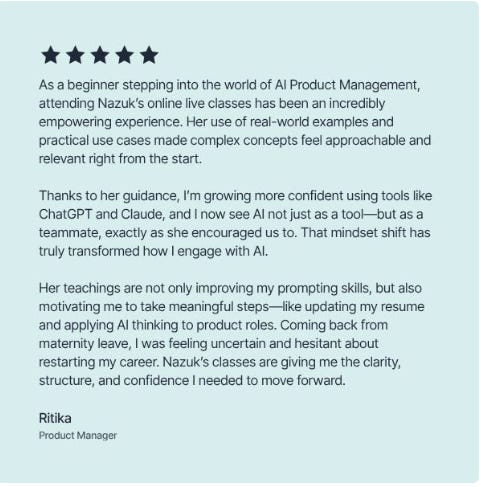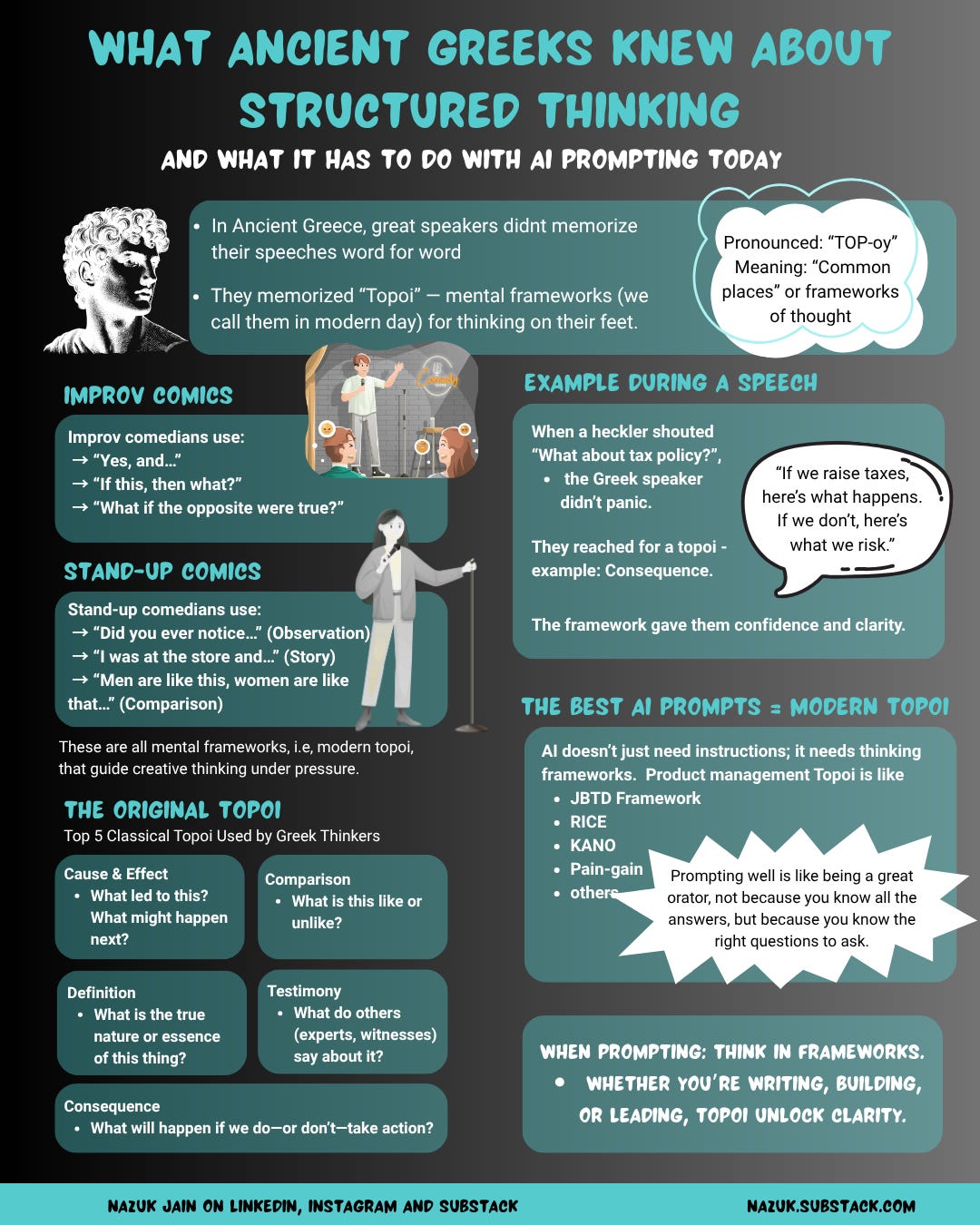⌚Saved 10+ hours on product discovery using AI
Ancient Greeks and Super IC PMs have this one thing in common
What if great prompts aren’t about wording but about thinking?
You are reading a 🔒paid-subscriber only edition 🔒
In today’s newsletter, I will walk you through how I ended up saving 10+ hours for a client on product discovery, effectively using AI.
How I saved 10+ hours on product discovery for a client
How can you replicate the process
How junior PMs, mid-level PMs, and product leaders can leverage AI (with different structured frameworks depending on domain knowledge.)
1.5 months ago, I announced that I was looking for a founding member for the “Become an AI PM” course. 30+ of you joined me, and instead of self-paced, I decided to deliver the classes LIVE. 2 learnings.
You can’t replace live classes learning with self-paced.
Not everyone’s schedule will fit LIVE classes, so building community helps
I have decided to teach “2nd LIVE Cohort” and craftfully also building community. if you are interested in this course with expanded material, starting from mid-August…
Here is what a student said from cohort 1.
Today’s Deep Dive
Last Tuesday, I spent 8 hours staring at 37 customer interview transcripts.( not a small number to go through manually if you have ever done so, you know)
My coffee went cold three times. Then I remembered something my college rhetoric professor said about ancient Greek speakers. It shifted my thinking about working with AI even more. It’s funny how life works.
It’s strange how the smallest ideas can plant seeds that can sprout years later, when the timing is just right.
That little memory reshaped how I now use AI not as a tool to offload work, but as a mirror for deeper thinking.
The 10-Hour Prompt
The usual process to extract insights from customer data would take me days, highlighting quotes, finding patterns, creating themes, and writing executive summaries.
Instead, I tried something different. I started with AI instead of AI as an afterthought.
I wrote one prompt:
"You are a senior UX researcher and strategist. Analyze the following transcript using Jobs to Be Done and Pain-Gain frameworks. Extract: (1) top user goals, (2) recurring pain points, (3) emotional triggers, (4) representative quotes, and (5) a one-slide summary for executives. Be concise, avoid assumptions, and use plain English."
5 minutes later, I had 60% of my synthesis done.
I gave the AI a structure to think through to which it gave me an output within those constraints.
Later in this essay, I dive into the exact steps on how I used AI + manual work to extract and organize the data.
What Ancient Greeks Knew About Thinking
My professor used to tell us about "topoi" (pronounced "TOP-oy"). In Ancient Greece, great speakers didn't memorize their speeches word-for-word. That would be impossible; they had to respond to hecklers, adapt to crowds, debate opponents on the fly.
Instead, they memorized thinking frameworks. Mental models, we call them in modern day, that they could use to approach any topic.
You know how improv comedians can be hilarious on the spot? They're not memorizing jokes they're using frameworks. "Yes, and..." for building on ideas. "If this, then what?" for exploring consequences. "What if the opposite were true?" for finding absurdity.
Stand-up comedians do the same thing. They have structures: "Did you ever notice..." (observation), "I was at the store and..." (story setup), "Men are like this, but women are like that..." (comparison).
The Greeks called these thinking frameworks "topoi"—and they're everywhere once you notice them.
Here are the main ones they used:
Cause and Effect: What led to this situation? What might happen next?
Comparison: What is this similar to? What's it different from?
Definition: What's the essence of this thing we're talking about?
Testimony: What do experts or witnesses say about this?
Consequence: If we do this, what happens downstream?
So instead of panicking when someone shouted "What about the tax policy?" during a speech, a Greek orator would think: "Okay, I'll use the consequence framework—what happens if we raise taxes versus if we don't?"
The best AI prompts work exactly like topoi.
They give AI a framework for thinking.
Most people write prompts like this: "Summarize these customer interviews."
But that's like asking someone to "say something smart" without giving them any structure. You'll get generic output because you haven't provided a thinking framework.
Better prompts work like this: "You're a product strategist. Use the Jobs to Be Done framework to analyze these interviews. For each customer, identify: the job they're trying to do, what's preventing them from doing it, and how they're working around the problem now."
See the difference? The second prompt gives the AI a mental model to think with.
Now with that mindset, let’s get straight to the steps
Keep reading with a 7-day free trial
Subscribe to Product Career to keep reading this post and get 7 days of free access to the full post archives.



